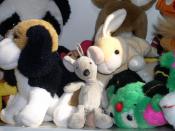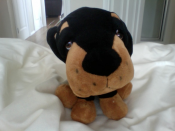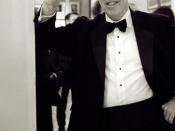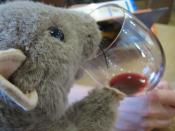Perhaps one of the more repulsive, yet cute, toys all of time, Jennifer Lew's stuffed "ca-ca" set the mark for oddball accessories in 2003. The ca-ca is plush, even pretty, but ca-ca nonetheless--ð furry rendition of excrement in the guise of ð stuffed animal. This homage to human refuse is just one of more than ð dozen plush objects Lew has completed in the 'last year and is selling to sudden success at New York's New Museum of Contemporary Art.
ànative of Queens, New York, Lew, 23, caught the design bug as ð student at Manhattan's High School of Fashion Industries, where she learned the essentials of sartorial form, structure, and sewing (jenniferlew.com). In college, she studied graphic design under Paul Sahre at the School of Visual Arts, completing ð whimsical thesis project in 2002 that had the theme "accumulation."Her final thesis publication was ð counting book for adults--count the knives, guns, drugs, and so on--that commented on the dangers surrounding urban kids.
After ð summer stint at the firm Design Machine, Lew became ð junior graphic designer at Simon & Schuster, assisting art directors such as John Fulbrook, Jackie Seow, and Michael Accordino.
DiscussionIn spite of the responsibilities of full-time work, Lew hatched ambitious plans for her off-duty pursuits. In the fall of 2002, she began making stuffed animals and objects. Her first creation, ð gift for ð niece, was ð turtle with ð detachable shell. àpink bunny emerged next from Lew's workshop, followed close behind by other fauna, ersatz edibles, and offbeat items.
Soon after she began the project, much of Lew's free time was devoted to producing the polyester-and-felt collectibles. Her stuffed-object repertoire includes ð set of drug paraphernalia that contains lines of cocaine and ð razor; ð stuffed cat in ð Velcro-fastened bunny suit; and edamame pods with removable soybeans. Like her counting book, these items embody the ephemera of adulthood in forms associated with children. They are unabashedly cute, yet adults--their primary collectors--embrace them.
Lew notes that there is continuity between her two creative lives. She says that she follows much the same process when developing the stuffed-object collection as she does when designing for the printed page, since both media require her to compose with varying palettes of colors, scales, and shapes.
She enjoys her day job, but she relishes the creative freedom that her stuffed collection allows and the tactile pleasure of handcrafting things. Lew adds that the handmade esthetic, with its inevitable flaws and blemishes, has an intrinsic charm: "It's about accepting that people and things are imperfect, but beautiful anyway (Reynolds, 1975)."ConclusionWhen Paul Sahre caught wind of the work, he arranged for Lew to show it to some colleagues at the New Museum (jenniferlew.com). They loved it, and in June 2003, Lew found herself with the daunting task of filling the Museum's window. She did, and the store continues to sell her work, in limited runs of ten to 20, at ð brisk pace. Designer Todd Oldham bought her ca-ca, and she's fielding ð bevy of stuffed-object offers. For Lew, still in her early twenties, the way forward may be unclear, but there's little doubt that her companions will be stuffed, plush, and just ð tad naughty.
ReferencesJennifer Lew, Retrieved from, http://www.jenniferlew.com/website2%20jpegs/index%20vs2%20bio.html, 2008Reynolds, J. (1975) Discourses on Art. Ed. Robert R. Wark. New Haven: Yale University Press.





